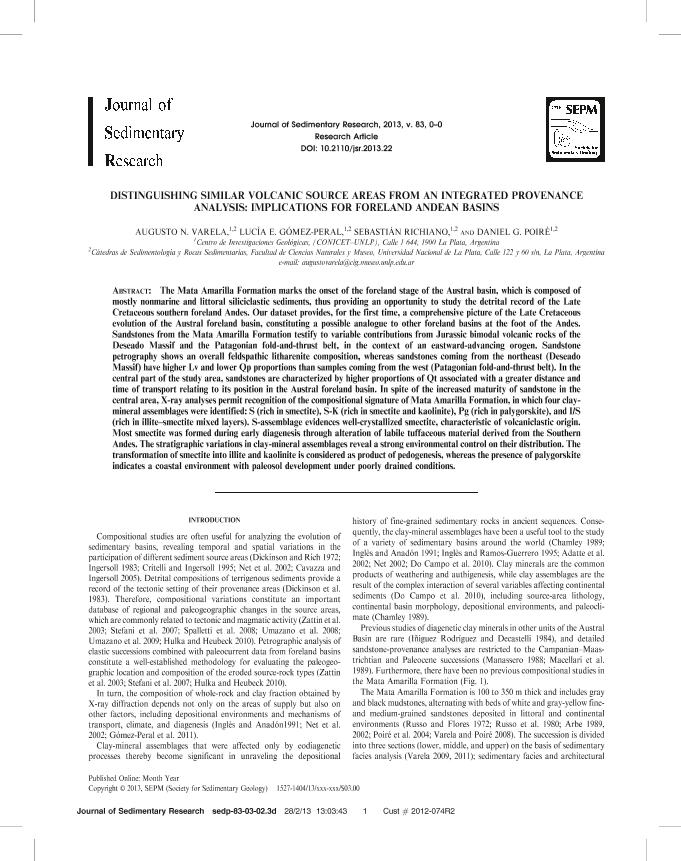Mostrar el registro sencillo del ítem
dc.contributor.author
Varela, Augusto Nicolás

dc.contributor.author
Gómez Peral, Lucia

dc.contributor.author
Richiano, Sebastián Miguel

dc.contributor.author
Poire, Daniel Gustavo

dc.date.available
2019-04-16T17:53:57Z
dc.date.issued
2013-03-24
dc.identifier.citation
Varela, Augusto Nicolás; Gómez Peral, Lucia; Richiano, Sebastián Miguel; Poire, Daniel Gustavo; Distinguishing similar volcanic source areas from an integrated provenance analysis: Implications for foreland Andean basins; Society for Sedimentary Geology; Journal of Sedimentary Research - (Print); 83; 3; 24-3-2013; 258-276
dc.identifier.issn
1527-1404
dc.identifier.uri
http://hdl.handle.net/11336/74483
dc.description.abstract
The Mata Amarilla Formation marks the onset of the foreland stage of the Austral basin, which is composed of mostly nonmarine and littoral siliciclastic sediments, thus providing an opportunity to study the detrital record of the Late Cretaceous southern foreland Andes. Our dataset provides, for the first time, a comprehensive picture of the Late Cretaceous evolution of the Austral foreland basin, constituting a possible analogue to other foreland basins at the foot of the Andes. Sandstones from the Mata Amarilla Formation testify to variable contributions from Jurassic bimodal volcanic rocks of the Deseado Massif and the Patagonian fold-and-thrust belt, in the context of an eastward-advancing orogen. Sandstone petrography shows an overall feldspathic litharenite composition, whereas sandstones coming from the northeast (Deseado Massif) have higher Lv and lower Qp proportions than samples coming from the west (Patagonian fold-and-thrust belt). In the central part of the study area, sandstones are characterized by higher proportions of Qt associated with a greater distance and time of transport relating to its position in the Austral foreland basin. In spite of the increased maturity of sandstone in the central area, X-ray analyses permit recognition of the compositional signature of Mata Amarilla Formation, in which four clay-mineral assemblages were identified: S (rich in smectite), S-K (rich in smectite and kaolinite), Pg (rich in palygorskite), and I/S (rich in illite-smectite mixed layers). S-assemblage evidences well-crystallized smectite, characteristic of volcaniclastic origin. Most smectite was formed during early diagenesis through alteration of labile tuffaceous material derived from the Southern Andes. The stratigraphic variations in clay-mineral assemblages reveal a strong environmental control on their distribution. The transformation of smectite into illite and kaolinite is considered as product of pedogenesis, whereas the presence of palygorskite indicates a coastal environment with paleosol development under poorly drained conditions. Copyright © 2013, SEPM (Society for Sedimentary Geology).
dc.format
application/pdf
dc.language.iso
eng
dc.publisher
Society for Sedimentary Geology

dc.rights
info:eu-repo/semantics/openAccess
dc.rights.uri
https://creativecommons.org/licenses/by-nc-sa/2.5/ar/
dc.subject
Upper Cretaceous
dc.subject
Greenhouse
dc.subject
Mata Amarilla Formation
dc.subject
Austral Foreland Basin
dc.subject
Patagonia
dc.subject.classification
Geología

dc.subject.classification
Ciencias de la Tierra y relacionadas con el Medio Ambiente

dc.subject.classification
CIENCIAS NATURALES Y EXACTAS

dc.title
Distinguishing similar volcanic source areas from an integrated provenance analysis: Implications for foreland Andean basins
dc.type
info:eu-repo/semantics/article
dc.type
info:ar-repo/semantics/artículo
dc.type
info:eu-repo/semantics/publishedVersion
dc.date.updated
2019-03-18T14:26:08Z
dc.journal.volume
83
dc.journal.number
3
dc.journal.pagination
258-276
dc.journal.pais
Estados Unidos

dc.journal.ciudad
Lawrence
dc.description.fil
Fil: Varela, Augusto Nicolás. Consejo Nacional de Investigaciones Científicas y Técnicas. Centro Científico Tecnológico Conicet - La Plata. Centro de Investigaciones Geológicas. Universidad Nacional de La Plata. Facultad de Ciencias Naturales y Museo. Centro de Investigaciones Geológicas; Argentina. Cátedras de Sedimentología y Rocas Sedimentarias, Facultad de Ciencias Naturales y Museo. Universidad Nacional de La Plata; Argentina
dc.description.fil
Fil: Gómez Peral, Lucia. Consejo Nacional de Investigaciones Científicas y Técnicas. Centro Científico Tecnológico Conicet - La Plata. Centro de Investigaciones Geológicas. Universidad Nacional de La Plata. Facultad de Ciencias Naturales y Museo. Centro de Investigaciones Geológicas; Argentina. Cátedras de Sedimentología y Rocas Sedimentarias, Facultad de Ciencias Naturales y Museo. Universidad Nacional de La Plata; Argentina
dc.description.fil
Fil: Richiano, Sebastián Miguel. Consejo Nacional de Investigaciones Científicas y Técnicas. Centro Científico Tecnológico Conicet - La Plata. Centro de Investigaciones Geológicas. Universidad Nacional de La Plata. Facultad de Ciencias Naturales y Museo. Centro de Investigaciones Geológicas; Argentina. Cátedras de Sedimentología y Rocas Sedimentarias, Facultad de Ciencias Naturales y Museo. Universidad Nacional de La Plata. calle 122 y 60 s/n. La Plata, Argentina; Argentina
dc.description.fil
Fil: Poire, Daniel Gustavo. Consejo Nacional de Investigaciones Científicas y Técnicas. Centro Científico Tecnológico Conicet - La Plata. Centro de Investigaciones Geológicas. Universidad Nacional de La Plata. Facultad de Ciencias Naturales y Museo. Centro de Investigaciones Geológicas; Argentina. Cátedras de Sedimentología y Rocas Sedimentarias, Facultad de Ciencias Naturales y Museo. Universidad Nacional de La Plata. calle 122 y 60 s/n. La Plata, Argentina; Argentina
dc.journal.title
Journal of Sedimentary Research - (Print)

dc.relation.alternativeid
info:eu-repo/semantics/altIdentifier/doi/http://dx.doi.org/10.2110/jsr.2013.22
dc.relation.alternativeid
info:eu-repo/semantics/altIdentifier/url/https://pubs.geoscienceworld.org/sepm/jsedres/article-abstract/83/3/258/330512
Archivos asociados
